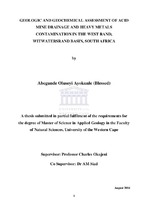| dc.description.abstract | Over the years, South Africa has produced over 468 million tons of mine waste yearly, in which gold mining waste accounted for 221 million tons (47%) of all mine waste produced, making it the largest, single source of waste and pollution. The exposure of these mine wastes such as tailings dams, waste rocks to oxidation and leaching has been the source of heavy metal release into the environment. This study assessed the magnitude of possibly leachable metals, its distribution and
associations and predicted the AMD load discharge over time, from Mogale’s tailings dam into the environs in Randfontein area, Witwatersrand Basin, South Africa. Fifty-one tailings dam samples were analysed for their mineral and multi-elements contents. Petrography studies was done by X-Ray Diffraction (XRD) technique to determine the mineralogical composition. X-ray fluorescence (XRF) and Inductively Coupled Plasma-Mass Spectrometry (ICP-MS) techniques were used to determine the multi-elements content in the tailings dam samples. The dataset were evaluated using multivariate statistics, Geographical Information Systems (GIS) and geochemical mass balance techniques. From the results, the tailings dam lithology was grouped into four distinct layers. The uppermost oxidized layer is siliceous and contains the highest SiO2 (87.32%) contents, which is with the lowest contents in Tot/S, U, As, Zn, Ni, Co, and Cu. A downward decrease in
SiO2 (76.39%) contents occurs, coupled by an increase in Fe2O3, Tot/S, U, As, Zn, Ni, Co, and Cu, reaching maximum contents in layer 3. Layer 4 is the least weathered horizon. The cluster analysis grouped the samples into four sub-clusters based on the variation in SiO2 and Al2O3 contents. Factor analysis (83.542% total data variance) related the four controlling factors of element distribution to the occurrence in ore elements (sulphides), silicates, mining additives and refractory minerals. Elements of the same origin show a similar concentration trend down hole in the GIS interpolation analysis. The geochemical mass balance showed variable gain and loss of oxides and trace elements within each layer. Based on the variation patterns of the Tot/S contents and other mobile elements, about 0.164kg/tonne/yr(±0.02) of the tailings materials are leached yearly. Layer 1 is the most altered. This assessment and prediction study therefore gives an insight to the geochemical behaviour of an abandoned tailings dam, highlighting its extent of oxidation. However, the interaction between the oxidized zone and transition zone should be given more attention, to determine the actual extent of damage. | en_US |

